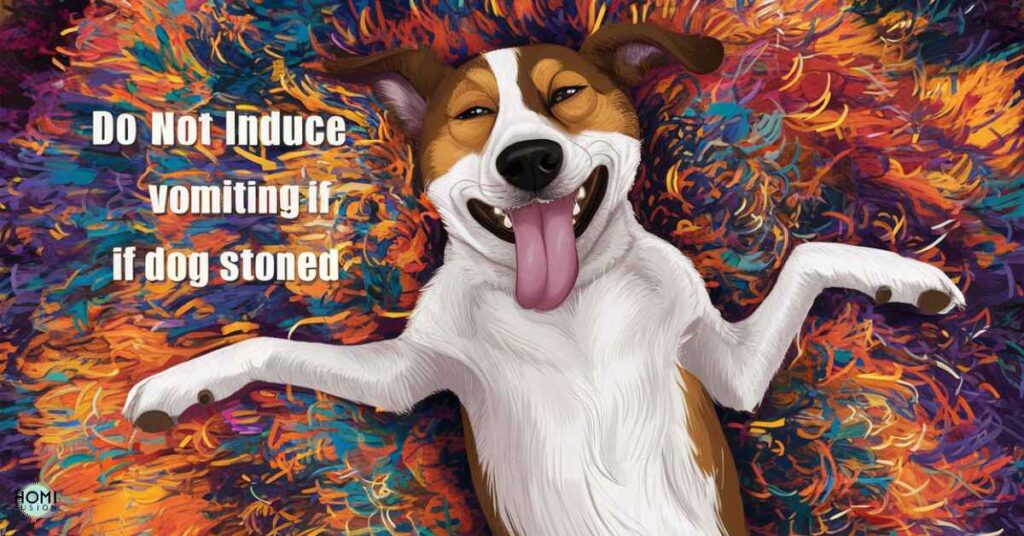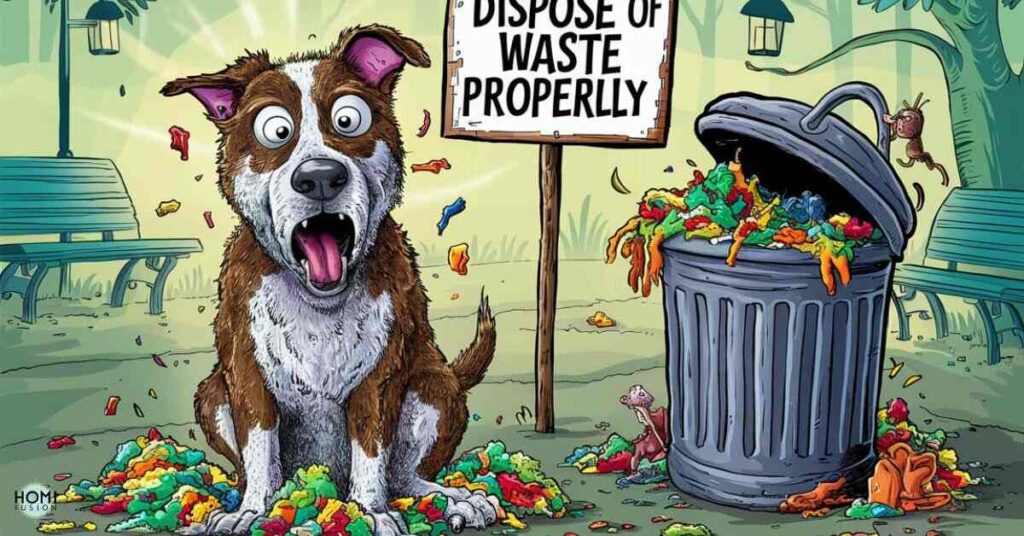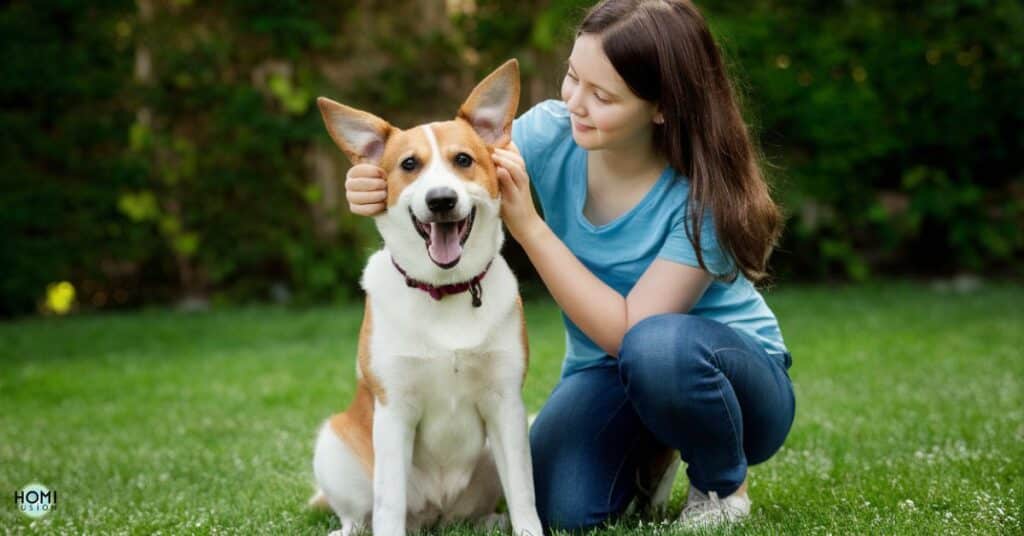Taking a dog that is experiencing the negative effects of weed is a process needing tenderness and urgency. It all starts from creating serene conditions within a poorly illuminated area. There should be comforting through hugging, providing water together with food besides caressing softly their ears.
It may also entail brushing them to make feel better. Concentrate more on preventing any disturbances but at the same time making it possible for them to catch some sleep-in peace during rehabilitation process.
Understanding the Situation
Dogs become intoxicated with marijuana when they accidentally eat cannabis products or when they inhale second-hand smoke. The active ingredient in marijuana is THC (Δ9-tetrahydrocannabinol), a substance that affects the nervous system of dogs and produces various symptoms.
Why Is My Dog Acting Stoned?
Dogs act stoned when they ingest marijuana or are exposed to THC. THC binds to receptors in their brain, affecting their perception, coordination and behavior. This can result in symptoms similar to intoxication in humans, such as lethargy, disorientation and altered responsiveness.
Effects of marijuana on dogs
- Lethargy and decreased activity levels
- Dilated pupils and increased heart rate
- Lack of coordination and balance
- Heightened anxiety and restlessness
- Increased appetite or lack of interest in food
Common signs of marijuana intoxication in dogs
Recognizing the signs of marijuana intoxication is crucial. Common symptoms include:
- Marijuana intoxication in dogs occurs due to accidental ingestion or exposure to THC.
- THC affects dogs’ neurological system, leading to symptoms similar to intoxication in humans.
- Common signs of marijuana intoxication include red eyes, drooling and loss of bladder control.
- Dogs may exhibit lethargy, disorientation and altered responsiveness when stoned.
- Behavioral changes in stoned dogs can include sluggish movements and changes in vocalization.
- Marijuana’s effects on dogs also include increased heart rate and dilated pupils.
- It’s crucial to recognize the signs of marijuana intoxication and seek prompt veterinary care.
- Treatment may involve inducing vomiting, administering activated charcoal and providing supportive care.
- Preventive measures include securely storing marijuana products and educating pet owners about the risks.
- Understanding the effects of marijuana on dogs helps in managing intoxication and ensuring their well-being.
Detailed descriptions of physical and behavioral signs

Red or Bloodshot Eyes: One of the most noticeable signs is redness or bloodshot appearance in the dog’s eyes. This is due to the dilation of blood vessels caused by THC.
Dilated Pupils: THC can also cause the pupils to dilate significantly, making them appear larger than usual even in well-lit environments.
Lack of Coordination or Balance Issues: Dogs may exhibit difficulty in walking or maintaining balance, often stumbling or swaying as if they are unsteady on their feet.
Lethargy or Extreme Drowsiness: Stoned dogs typically appear excessively sleepy or lethargic, often lounging or lying down for extended periods without much activity.
Increased Appetite or “the Munchies: Some dogs may display a sudden increase in appetite, showing interest in food more than usual or even scavenging for snacks.
Unusual Vocalizations or Changes in Barking: Dogs affected by marijuana may exhibit unusual vocalizations or changes in barking, appearing confused or disoriented. These behaviors can indicate intoxication and require careful observation and attention.
Disorientation or Confusion: Stoned dogs may seem disoriented or confused, struggling to navigate familiar spaces or appearing lost in their surroundings.
Increased Sensitivity to Stimuli: Under the influence of marijuana, dogs can become highly sensitive to sensory inputs like noise or light. They may react strongly to minor disturbances that they would typically ignore.
Loss of Bladder Control or Accidents Indoors: In severe cases, dogs may experience loss of bladder control, leading to accidents indoors or an inability to hold their urine.
Changes in Behavior, such as Increased Anxiety or Agitation: Marijuana intoxication can also manifest as heightened anxiety, restlessness, or agitation, with dogs displaying nervous behaviors or seeming on edge.

Read this blog: How To Get The Smell Of Skunk Out Of Your House
Differentiation between typical dog behavior and stoned behavior
Differentiating between typical dog behavior and stoned behavior requires keen observation and an understanding of the signs associated with marijuana intoxication. Here’s how you can distinguish between the two:
| Behavior | Typical Dog Behavior | Stoned Behavior |
| Eyes | Clear, normal appearance | Red or bloodshot eyes, dilated pupils |
| Coordination | Smooth movements and balanced walking | Lack of coordination, stumbling or swaying |
| Energy Level | Active and alert | Lethargic, reduced activity levels |
| Appetite | Consistent interest in food | Sudden increase in appetite or loss of interest |
| Responsiveness | Responsive to stimuli and commands | Altered responsiveness, delayed reactions |
| Vocalizations | Normal barking patterns | Unusual vocalizations, changes in barking |
| Sensitivity | Normal reaction to noise and light | Hypersensitivity to noise and light |
| Disposition | Calm and relaxed | Increased anxiety or restlessness |
| Coordination | Normal gait and movements | Sluggish movements, difficulty in walking |
| Awareness | Alert and aware of surroundings | Disoriented, confused behavior |
Immediate Actions if your dog gets high
If your dog gets high or shows signs of marijuana intoxication, taking immediate actions is crucial to ensure their safety and well-being. Here are the steps you should follow:

Stay Calm: It’s important to stay calm and composed to handle the situation effectively.
Remove Them from the Source: If your dog ingested marijuana, remove them from the area where the ingestion occurred to prevent further exposure.
Contact a veterinarian: Immediately contact your veterinarian or an emergency animal poison control hotline for guidance and assistance. Provide details such as the amount ingested, time of ingestion, and your dog’s weight.
Observe and Monitor: Keep a close eye on your dog’s symptoms and behavior. Note any changes or worsening of symptoms.
Do Not Induce Vomiting: Do not attempt to induce vomiting unless advised by a veterinarian. Improper vomiting can lead to complications.

Keep Them Calm: Place your dog in a quiet, dimly lit room to reduce stimulation and keep them calm. Avoid loud noises or sudden movements.
Offer Water: Keep your dog hydrated by offering small amounts of water. Do not force them to drink if they are not interested.
Do Not Administer Home Remedies: Avoid giving any home remedies or medications without veterinary guidance, as they may worsen the situation.
Prepare for Veterinary Visit: Gather any information related to the ingestion, including the packaging or remnants of the substance, to provide to the veterinarian.
Follow Veterinarian’s Advice: Follow the veterinarian’s advice carefully, whether it involves monitoring at home or immediate medical treatment.
How To Get A Dog Unstoned At Home
Getting a dog unstoned at home requires careful attention and a supportive approach. Here are steps you can take:
Create a Calm Environment
Place your dog in a quiet, dimly lit room to reduce stimulation and help them relax.
Offer Water and Hydration
Keep your dog hydrated by offering small amounts of water frequently.
Provide Comfort and Reassurance
Offer cuddles, pets, and gentle massages to provide comfort and reassurance.
Keep Them Fed
Offer a small amount of their regular food to encourage eating. Avoid giving treats or unfamiliar foods.
Monitor and Observe
Keep a close eye on your dog’s behavior and symptoms. Note any improvements or worsening of their condition.
Avoid Overstimulation
Minimize noise, bright lights and activities that could overstimulate your dog.
Encourage Rest
Allow your dog to rest and sleep as needed to aid in recovery.
Seek Veterinary Advice
If symptoms persist or worsen, or if you’re unsure about how to proceed, contact your veterinarian for guidance and support.
Precautionary Measures
Precautionary measures to prevent accidental marijuana intoxication in dogs include:
Secure Storage: Keep marijuana products securely stored in a locked cabinet or high shelf out of your dog’s reach.
Dispose of Waste Properly: Dispose of marijuana waste, including edibles packaging or leftover plant material, in a sealed container for safety. Then, ensure it is placed in a secure trash bin to prevent accidental ingestion by pets or children.

Educate Family Members: Educate everyone in your household about the dangers of marijuana ingestion for dogs and the importance of keeping it out of reach.
Be Aware of Secondhand Smoke: Avoid exposing your dog to secondhand marijuana smoke, as inhalation can also lead to intoxication.
Pet-Safe Environment: Create a pet-safe environment by removing any potential hazards or temptations, such as plants or substances that dogs may ingest.
Monitor Outdoor Activities: Supervise your dog during outdoor activities to prevent access to discarded marijuana products or contaminated areas.
Emergency Preparedness: Familiarize yourself with the signs of marijuana intoxication in dogs for prompt recognition. Keep contact information for your veterinarian or an animal poison control hotline easily accessible in case of emergencies.
Treatment and Care
Treatment and care for a dog experiencing marijuana intoxication involve the following steps:
Contact Veterinarian: Immediately contact your veterinarian or an emergency animal poison control hotline for guidance and assistance.

Provide Information: Provide details such as the amount ingested, time of ingestion, and your dog’s weight to the veterinarian.
Avoid Home Remedies: Do not attempt to induce vomiting or administer any home remedies without veterinary guidance, as they may worsen the situation.
Create a Calm Environment: Place your dog in a quiet, dimly lit room to reduce stimulation and help them relax.
Hydration: Keep your dog hydrated by offering small amounts of water frequently. Do not force them to drink if they are not interested.
Comfort and Reassurance: Offer cuddles, pets, and gentle massages to provide comfort and reassurance.
Monitor Symptoms: Keep a close eye on your dog’s behavior and symptoms. Note any changes or worsening of their condition.
Follow Veterinarian’s Advice: Follow the veterinarian’s advice carefully, whether it involves monitoring at home or immediate medical treatment.
Administer Treatment: If recommended by the veterinarian, administer activated charcoal or other medications as instructed.
Follow-Up Care: Follow any follow-up care instructions provided by the veterinarian, including scheduled check-ups or additional treatments if necessary.
Rub Their Ears

Rubbing your dog’s ears gently can help soothe and comfort them, especially if they are experiencing marijuana intoxication. Here’s how to do it effectively and safely:
Create a Calm Environment: Before rubbing your dog’s ears, ensure they are in a quiet and calm environment to minimize stress.
Approach Slowly: Approach your dog calmly and slowly to avoid startling them. Speak to them in a soothing tone to reassure them.
Check for Sensitivity: Before proceeding, gently touch your dog’s ears to check for any signs of sensitivity or discomfort. If they pull away or show signs of pain, avoid rubbing their ears.
Use Gentle Strokes: Using your fingertips, gently massage the base of your dog’s ears in a circular motion. Avoid applying too much pressure or rubbing vigorously.
Observe Their Reaction: Pay attention to your dog’s body language and response while you rub their ears. If they seem relaxed and enjoy the ear rub, continue for a few minutes.
Monitor for Improvement: After rubbing their ears, observe if your dog shows signs of relaxation or comfort. Some dogs may find ear rubs soothing and calming.
Repeat as Needed: You can repeat the ear rubs as needed to help comfort your dog during their recovery from marijuana intoxication.
Brush Them
Brushing your dog can be a helpful and calming activity, especially if they are experiencing marijuana intoxication. Here’s how to brush your dog effectively and safely:

Choose the Right Brush: Use a brush suitable for your dog’s coat type, such as a slicker brush for long-haired breeds or a bristle brush for short-haired breeds.
Create a Calm Environment: Brush your dog in a quiet and calm area to minimize stress and distractions.
Approach Slowly: Approach your dog calmly and gently. Speak to them in a soothing tone to reassure them.
Start with the Body: Begin brushing your dog’s body first before moving to their head and ears. Use gentle strokes in the direction of hair growth to avoid pulling or tugging.
Brush the Chest and Belly: Pay attention to brushing the chest and belly areas, as these can be sensitive and prone to matting.
Brush the Legs and Tail: Brush your dog’s legs and tail gently, taking care around joints and sensitive areas.
Brush the Head and Ears: Use a soft brush or a specialized ear brush to gently clean and brush your dog’s head and ears. Avoid getting water or cleaning solutions inside the ears.
Observe Their Reaction: Pay attention to your dog’s body language and response while brushing. If they seem relaxed and enjoy the brushing session, continue for a few minutes.
Monitor for Improvement: After brushing, observe if your dog appears more comfortable or relaxed. Some dogs may find brushing soothing and calming.
Repeat as Needed: You can brush your dog regularly to help maintain their coat health and provide them with a comforting and bonding activity.
Also read: Can Fleas Travel On Humans To Another House?
Understanding the Effects of Marijuana Ingestion in Dogs
When a dog ingests marijuana, it can lead to a range of symptoms and potential dangers that require immediate attention. Understanding these effects is crucial for pet owners to recognize the signs of intoxication and take appropriate action.
Symptoms to Look Out For
Symptoms of marijuana ingestion in dogs include lethargy, dilated pupils, loss of coordination, increased heart rate, vomiting and changes in behavior like anxiety or agitation. These signs indicate marijuana intoxication and can vary in severity based on factors like the amount ingested and the dog’s size.
Potential Dangers of Marijuana Ingestion
The potential dangers of ingesting marijuana for dogs are significant. It can depress the central nervous system, leading to coma or seizures. Serious health risks from marijuana ingestion in dogs include respiratory depression, abnormal heart rhythms, and gastrointestinal upset. Neurological symptoms like tremors and ataxia can also occur, necessitating immediate veterinary attention.
Early Warning Signs
Early warning signs of marijuana ingestion in dogs encompass finding chewed marijuana products, detecting a strong marijuana odor on the dog’s breath or fur, and observing physical symptoms like dilated pupils or red eyes.
Additionally, noticing unusual behavior or responsiveness changes and signs of gastrointestinal distress like vomiting or drooling can also indicate ingestion. Recognizing these signs promptly is crucial for seeking veterinary care and preventing complications.
Can Dogs Die From Weed?
Dogs can experience severe health complications from ingesting weed, but fatal cases are rare. Marijuana toxicity can lead to severe symptoms like seizures and respiratory depression, but quick veterinary care can prevent fatalities. Immediate intervention is crucial in managing the distress and potential life-threatening effects of marijuana ingestion in dogs.
However, the severity of the situation depends on factors like the amount ingested, the dog’s size, and their overall health. It’s crucial for pet owners to recognize the risks of marijuana ingestion in dogs and act promptly if their dog shows signs of intoxication. Seeking immediate medical attention can prevent complications and ensure the dog’s well-being.
Will the Vet Report Me to the Police?
In cases of marijuana intoxication in dogs, veterinarians prioritize the health and well-being of the animal. They are bound by professional ethics and confidentiality, similar to human medical professionals. Veterinarians usually refrain from reporting pet owners to the police unless there are additional concerns like animal cruelty or illegal activities.
Their focus remains on providing medical care and ensuring the well-being of animals. Their primary focus is on providing medical care to the affected animal and offering guidance to pet owners to prevent future incidents. However, it’s essential to be honest with your veterinarian about the situation to ensure your dog receives the appropriate treatment.
Frequently asked questions
How do I sober up my dog?
To sober up your dog, provide a calm environment and monitor their behavior closely. Contact a veterinarian for guidance and support.
How long does it take for a dog to stop being high?
The duration for a dog to stop being high can vary widely based on factors like the amount ingested and the dog’s size. Generally, effects may last several hours to a day, but severe cases may require longer recovery periods under veterinary care.
How do you discipline a dog that won’t listen?
Consistent training methods, positive reinforcement, and clear communication can help discipline a dog that won’t listen. Consider professional obedience classes or consulting with a certified dog trainer for tailored guidance.
Will my dog forgive me for hitting him?
Dogs may forgive, but it’s essential to avoid physical punishment as it can damage trust and worsen behavior. Focus on positive reinforcement and gentle training methods for a healthy bond with your dog.
How to punish a puppy for biting?
Redirect the puppy’s biting behavior by offering appropriate chew toys and rewarding calm behavior. Avoid physical punishment and instead use positive reinforcement techniques to encourage gentle play.
Conclusion
There is a need for a calm environment when nursing a dog with marijuana poisoning. Put the dog in a lowly lit room and take time to give it ample encouragement and hugs. Ensure they are drinking water frequently as well as observing their behavior patterns change over time on any of them improving.
Plus, do not subject such an animal to extra stress or excitement but create favorable conditions meant for comfortable rest and quick recovery. The vet must see it, if things are getting out of hand or the signs remain the same for long.







